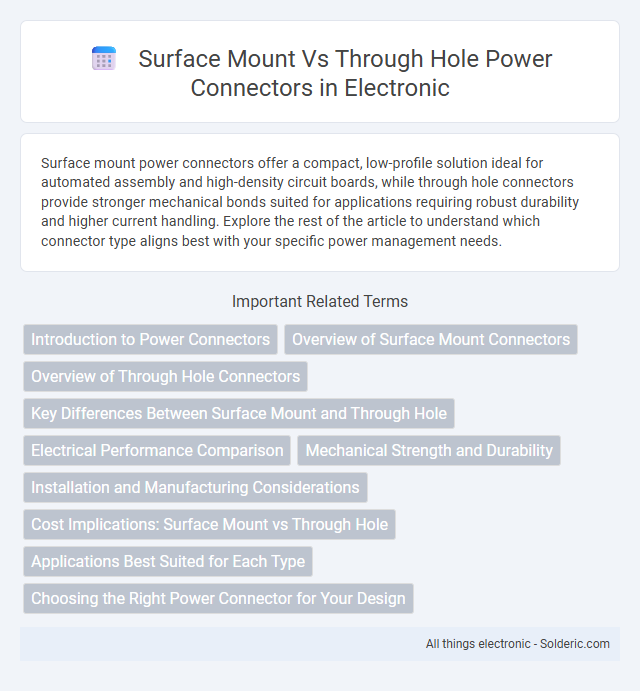Surface mount power connectors offer a compact, low-profile solution ideal for automated assembly and high-density circuit boards, while through hole connectors provide stronger mechanical bonds suited for applications requiring robust durability and higher current handling. Explore the rest of the article to understand which connector type aligns best with your specific power management needs.
Comparison Table
| Feature | Surface Mount Power Connectors | Through Hole Power Connectors |
|---|---|---|
| Mounting Method | Mounted directly on PCB surface | Leads inserted through PCB holes |
| Assembly Process | Compatible with automated pick-and-place | Requires manual or wave soldering |
| Mechanical Strength | Lower mechanical strength compared to through hole | Higher mechanical stability and durability |
| Size and Weight | Smaller, lighter for compact designs | Larger, heavier components |
| Electrical Performance | Good for high-frequency signals | Better for high current and power handling |
| Repair and Replacement | More difficult to rework | Easier to repair and replace |
| Cost | Generally lower assembly cost | Higher assembly and labor costs |
| Applications | Consumer electronics, compact devices | Industrial, power supply, and high-reliability uses |
Introduction to Power Connectors
Power connectors serve as critical interfaces for electrical power transfer in electronic devices, with Surface Mount Technology (SMT) and Through Hole Technology (THT) as primary mounting methods. SMT power connectors offer compact designs and improved signal integrity by soldering directly onto PCB surfaces, enhancing efficiency in high-density circuit boards. Conversely, THT power connectors provide robust mechanical stability and higher current capacity through pins inserted into drilled holes, ideal for applications requiring durability and heavy power loads.
Overview of Surface Mount Connectors
Surface mount power connectors are designed to be mounted directly onto the surface of a printed circuit board (PCB) without the need for drilled holes, enabling higher component density and streamlined automated assembly processes. These connectors offer excellent electrical performance and mechanical stability for compact electronic devices, supporting fast signal transmission and reliable power delivery. Their low-profile design and compatibility with advanced manufacturing techniques make them ideal for modern consumer electronics, telecommunications, and automotive applications.
Overview of Through Hole Connectors
Through hole power connectors feature leads that are inserted into drilled holes on a printed circuit board (PCB) and soldered on the opposite side, providing robust mechanical strength and reliable electrical connections. These connectors are preferred in applications requiring high durability and withstand mechanical stress, such as industrial equipment and power supplies. Despite their larger size compared to surface mount connectors, through hole types ensure superior heat dissipation and enhanced current-carrying capacity.
Key Differences Between Surface Mount and Through Hole
Surface mount power connectors are designed for direct placement on the PCB surface, allowing for higher component density and automated assembly processes, whereas through hole connectors require pins to be inserted into drilled holes, providing superior mechanical stability. Surface mount connectors offer faster production times and are ideal for compact, lightweight electronic devices, while through hole connectors excel in high-stress environments where durability and strong physical connections are critical. The choice between the two depends on factors like mechanical strength, assembly method, and application-specific requirements in power electronics.
Electrical Performance Comparison
Surface mount power connectors offer lower parasitic inductance and capacitance, resulting in improved high-frequency performance and signal integrity compared to through hole connectors. Through hole connectors provide superior mechanical strength and can handle higher current loads, which benefits applications requiring robust power delivery. The choice depends on balancing electrical efficiency and mechanical durability for specific power applications.
Mechanical Strength and Durability
Through hole power connectors provide superior mechanical strength and durability due to their leads passing through the PCB, creating a robust physical and electrical bond that resists vibration and mechanical stress. Surface mount power connectors rely on solder joints on the PCB surface, which offer less mechanical support but enable more compact and lightweight designs ideal for high-density applications. Your choice depends on whether mechanical durability or space-saving design is the priority for your specific power distribution needs.
Installation and Manufacturing Considerations
Surface mount power connectors enable automated placement and soldering processes, reducing assembly time and improving manufacturing efficiency compared to through hole connectors, which necessitate manual or wave soldering due to their lead insertion requirements. Through hole connectors offer superior mechanical strength and stability for applications subject to physical stress, making them ideal for rugged environments despite higher installation complexity. The choice between surface mount and through hole power connectors affects PCB design considerations, assembly cost, and production speed, with surface mount favoring high-volume manufacturing and through hole suited for durability-critical use cases.
Cost Implications: Surface Mount vs Through Hole
Surface mount power connectors generally offer lower manufacturing costs due to automated placement and reduced material usage, making them ideal for high-volume production. Through hole connectors tend to have higher costs because of manual assembly requirements and increased labor time, but they provide stronger mechanical bonds suitable for stress-prone applications. Your choice between these technologies impacts cost efficiency and reliability based on production scale and environmental demands.
Applications Best Suited for Each Type
Surface mount power connectors excel in compact electronics, high-density circuit boards, and automated assembly processes, making them ideal for consumer electronics, laptops, and smartphones. Through hole power connectors provide superior mechanical stability and current-carrying capacity, suited for industrial equipment, power supplies, and automotive applications where durability and strong physical connections are critical. Selecting between surface mount and through hole connectors depends on device size constraints, electrical requirements, and environmental conditions.
Choosing the Right Power Connector for Your Design
Selecting the right power connector for your design involves evaluating factors such as space constraints, durability, and current-carrying capacity. Surface mount connectors offer compact size and automated assembly benefits, ideal for high-density electronics, while through hole connectors provide stronger mechanical bonds and higher power handling for robust applications. Assess your device's mechanical stress, thermal requirements, and manufacturing process to ensure optimal connector performance and reliability.
Surface Mount vs Through Hole Power Connectors Infographic

 solderic.com
solderic.com